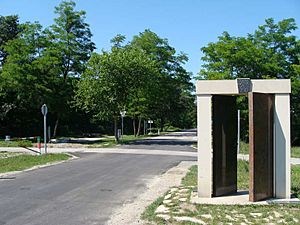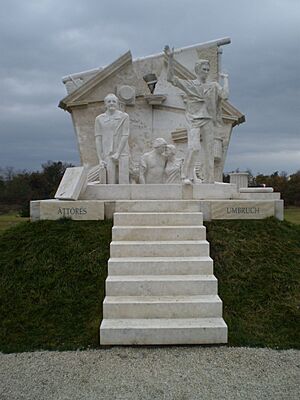Paneuropean Picnic facts for kids
The Pan-European Picnic was a special event that happened on August 19, 1989. It took place on the border between Austria and Hungary, near a Hungarian town called Sopron. This event was a big step towards ending the Cold War and bringing Germany back together.
Contents
The Pan-European Picnic Event
The Pan-European Picnic was planned as a peaceful demonstration. Both Austria and Hungary agreed to open a gate in the border fence for a few hours. This gate was located between Sankt Margarethen im Burgenland in Austria and Sopronkőhida in Hungary.
Important leaders involved were Otto von Habsburg and the Hungarian minister, Imre Pozsgay. The person who actually cut the border fence was Walburga Habsburg Douglas from the International Paneuropean Union. The gate was meant to be open for three hours as a symbol of peace and freedom.
Unexpected Border Crossing
More than 600 people from East Germany saw this as a chance to escape to the West. They had heard about the event from its organizers. At that time, the Hungarian border police had strict orders to stop anyone trying to cross the border without permission. However, during the picnic, they acted carefully and did not shoot at the people who were trying to escape.
The Outcome of the Picnic
On that first day, only a few hundred people managed to cross the border into the West. In the days that followed, the Hungarian government watched the border more closely. This meant fewer people could escape right away. However, on September 11, 1989, Hungary made a big decision: it officially opened its borders to all citizens of East Germany.
Remembering the Pan-European Picnic
Today, the Pan-European Picnic is seen as one of the most important events that helped end the German Democratic Republic (East Germany) and the Cold War. It also led to the fall of the Iron Curtain and the unification of the two German states.
The event is celebrated every year on August 19 at the exact spot where the border was opened.
Memorials and Artwork
At the site where the fence was cut, there is now artwork by Hungarian artists. It shows a door that is partly open, symbolizing the new freedom.
In 1996, a 10-meter-tall statue was built in Fertőrákos, near Sopron. This statue was created by Gabriela von Habsburg. It looks like a piece of barbed wire, but from far away, it also looks like a cross.
Images for kids
See also
 In Spanish: Pícnic Paneuropeo para niños
In Spanish: Pícnic Paneuropeo para niños






